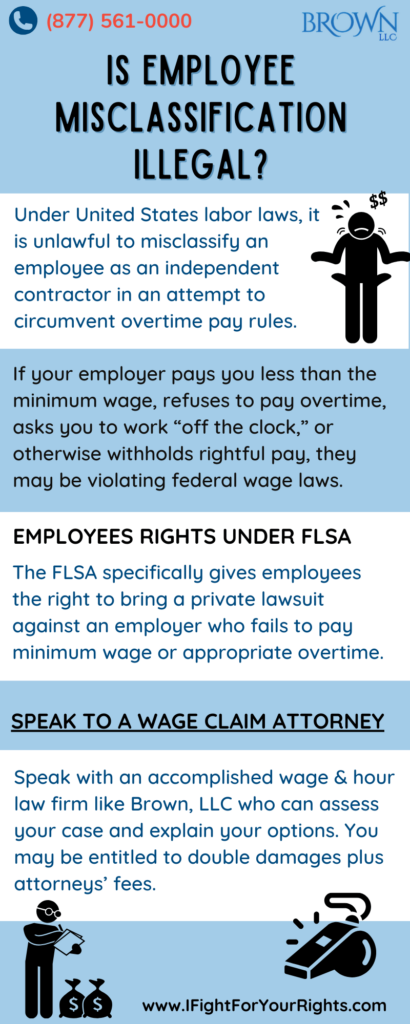Is Employee Misclassification Illegal?

Table of Contents
Yes. Under United States labor laws, it is unlawful to misclassify an employee as an independent contractor. This wrongful practice is often used to improperly evade paying workers time and a half for hours over 40 which is a Fair Labor Standards Act violation, as well as a violation of most state laws labor rights. Additionally, since treating a worker as an independent contractor circumvents certain tax withholdings there may be a separate cause of action under the IRS Whistleblower laws if the aggregate amount of unpayment of payroll taxes is above $2 million.
Further, many states like California and New Jersey have labor codes that go far beyond federal law and err on classifying workers as employees under the ABC tests. The gravity of failing to pay workers their proper overtime is viewed as “wage theft” in certain states which shows how important those jurisdictions think these classification violations are.
The government prefers to see workers classified as employees because it creates additional revenue through taxation and employees have federal and state wage and hour protections that independent contractors do not. By law, your employer must pay you minimum wage and time and a half for work performed in excess of 40 hours. However, this is not the case for independent contractors who are treated as if they are in business for themselves. Despite their legal obligations, employers often try to classify people as independent contractors to get around the wage and hour laws.
Can I Sue my Employer for Misclassification?
Potentially, yes. If an employer is classifying you as an independent contractor to avoid paying proper wages, that is to evade their overtime pay requirements, you may have grounds to sue them. Although you can learn about your employment rights here, you should seek clarification about your status from an employee misclassification lawyer. The difference between an employee and an independent contractor is defined in the law. It takes legal know-how to determine your status and file a misclassification lawsuit to maximize your chances of success.
What is Misclassification under the FLSA?
The Fair Labor Standards Act (FLSA) governs employee minimum wage and overtime pay and establishes other mandates around an employer. This law dictates what an employer must pay employees when an employer-employee relationship exists. Thus, an employer who hires a worker must follow the FLSA compensation rules regardless of whether they call the worker an independent contractor or not, if the law views the individual as an employee.
Misclassification under the FLSA occurs when an employer hires a worker as an independent contractor but treats them as an employee. When that happens, the worker and employer may try to evade paying minimum wage, overtime, and other protections the FLSA affords. The worker may then file a misclassification lawsuit, and, if the worker prevails, they may be entitled to double damages plus attorney’s fees for up to three years of damages under the FLSA and maybe more under certain state laws.
Over 100 million in judgments and settlements trials in state and federal courts.
We fight for maximum damage and results.Speak with the Lawyers at Brown, LLC Today!
Quirky Damages Calculation in FLSA Misclassification Cases
When an employee is misclassified as exempt from overtime and is later found entitled to overtime, the method of calculating damages isn’t always what you might expect. Under federal law, and especially as clarified in Urnikis-Negro v. American Family Property Services, 616 F.3d 665 (7th Cir. 2010), courts may apply a legal fiction that significantly affects how much the worker recovers.
- Straight Time Already Paid
If the worker was already paid straight time for all hours worked, including overtime hours (i.e., no overtime premium but at least their regular rate), then they are typically owed the half-time premium for the overtime hours, which is then doubled under the FLSA’s liquidated damages provision. - Salary Exceeding Minimum Wage (Legal Fiction)
If the worker was paid a fixed salary, and that salary—when divided by total hours worked—exceeds minimum wage, courts may treat that salary as having covered all straight time, including overtime. In that case, the worker is only owed the half-time premium for hours over 40.
This “half-time only” approach is based on the idea that the employer already compensated the employee for all hours worked, and only failed to pay the required overtime premium. The reasoning derives from the fluctuating workweek method and is heavily influenced by the Urnikis-Negro decision. However, there are potential attacks on that rationale and some state laws explicitly reject the legal fiction. After all, if the employer is doing the employee wrong, why should they receive the retroactive benefit and credit of its misconduct.
How do I Know if I Am an Employee or an Independent Contractor?
The guidelines both federal and state have set forth criteria that help determine a worker’s classification – which has very little to do with what the label of the worker is agreed on or otherwise. The foundation for the determination under the FLSA is the economic realities test.
According to the Department of Labor, 29 CFR Part 795 guides employers and employees on the factors determining status. First, a worker’s label as an independent contractor is not decisive (29 CFR 795.105(a)). The analysis of employee status hinges on the economic relationship between employer and employee. An employee who is economically dependent on their employer, measured by the economic reality test, is deemed an employee regardless of their independent contractor title.
The economic reality test outlined in 29 CFR 795.105 considers six factors: “opportunity for profit or loss depending on managerial skill,” “investments by the worker and potential employer,” “degree of permanence of the work relationship,” “nature, and degree of control, extent to which the work performed is an integral part of the employer’s business,” and “skill and initiative.” Each factor may play a greater or lesser role in determining employee status.
In essence, an employee is less likely to have economic control over profits or losses based on their decisions, purchases, marketing, and other efforts. They have less control over their work and economic gains than an independent contractor, but their employment is more permanent due to the specific skills and contributions integral to the employer’s business.
A worker who provides services to an employer, using tools they purchased to perform work for the employer and other employers, on a specific project with a start and end date is more likely an independent contractor. An employer may hire such a worker as an electrician, plumber, or engineer to perform services over a short-term or lengthy project. This type of individual probably has more discretion over their methods and how they apply their experience to complete the job. When the project is over, they no longer work for the employer.
So, regardless of whether an employer gives you a 1099 form as an independent contractor at the end of the year you may not be one if your employer controls how you perform your job, how you are paid, and what you receive in the contractual relationship. Do you receive benefits, such as insurance, sick pay, or retirement typically offered to employees? Is your work closely managed and ordered by your employer? These factors and others may determine status.
The distinction is not always clear, so a judge or labor board must analyze the factors that apply to each worker’s circumstances.
How Can an Employee Misclassification Lawyer Help?
Before you file a lawsuit, an employee misclassification lawyer will review the factors established regarding your employment relationship and circumstances to advise you of possible or probable legal rights violations under the FLSA and other state wage and hour statutes.
Since an employment attorney is equipped with an understanding of the economic reality test a court might use, they can explain which factors apply, their respective weight, and the potential outcomes of your claim against your employer. In other words, they can analyze your case the way a judge might help you decide whether to pursue your misclassification lawsuit.


